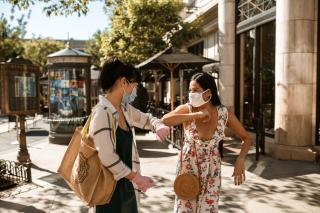Touch Consent
By Melanie Davis

At the 2024 UUA General Assembly, we voted to “Center Love” Amidst the Ongoing Impact of COVID-19 as an action of immediate witness.
As part of this commitment, we need to be mindful about boundaries in our interpersonal interactions, especially around touch.
Melanie Davis, author of the Our Whole Lives curriculum can give us us some guidance!
Consent
Considering the OWL framework of consent can be helpful, but it’s not as simple as “Would you like a handshake/hug?”
We now need to communicate clearly and directly:
“I’d love to offer you a hug. My risk exposure in the past two weeks has been X. Please tell me yours so we can make a risk-aware decision.”
It’s similar to making decisions about risk-aware sexual contact but perhaps more challenging because people may think, “It’s just a hand shake” or “It’s just a hug” or “I only went to one crowded party…”
Also, they may know their personal risk exposure, but they may be unaware that someone in their family may have brought the virus home.
Rethinking Touch
We will need to rethink congregational touch as a form of comfort, community, and blessing.
For example, as a lay preacher, I will no longer invite people to hold hands during Benediction. I won’t participate in post-service Greet the Speaker hand shaking lines.
If I were a minister conducting Dedications, I would not carry newborns among the pews for community blessing. As a congregant, I would skip the Circle Dance group unless masks are required and everyone takes hand sanitizer breaks. And so on…
Maybe it would help to adopt a touch-free way of indicating care and compassion. Here are a few examples, but you might come up with more:
- Invite people to stand apart and open their arms wide to each other, visualizing that their hearts are open to each other (which is also a form of energy exchange).
- Hold the hands in prayer position over the heart with a slight bow to honor the spirit within (commonly known as “Namaste”).
- Offer a nod while giving yourself a hug to signal a virtual hug.